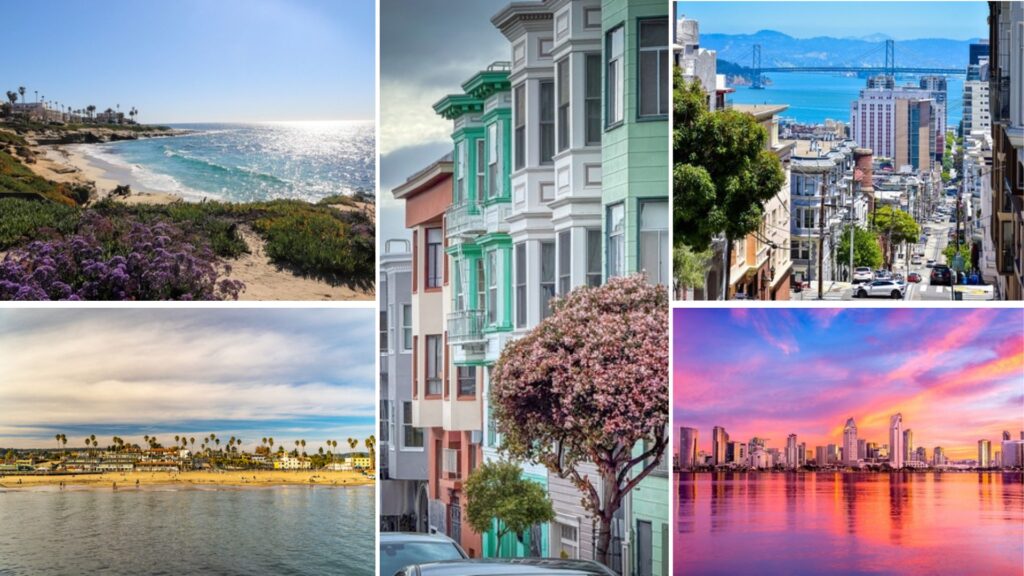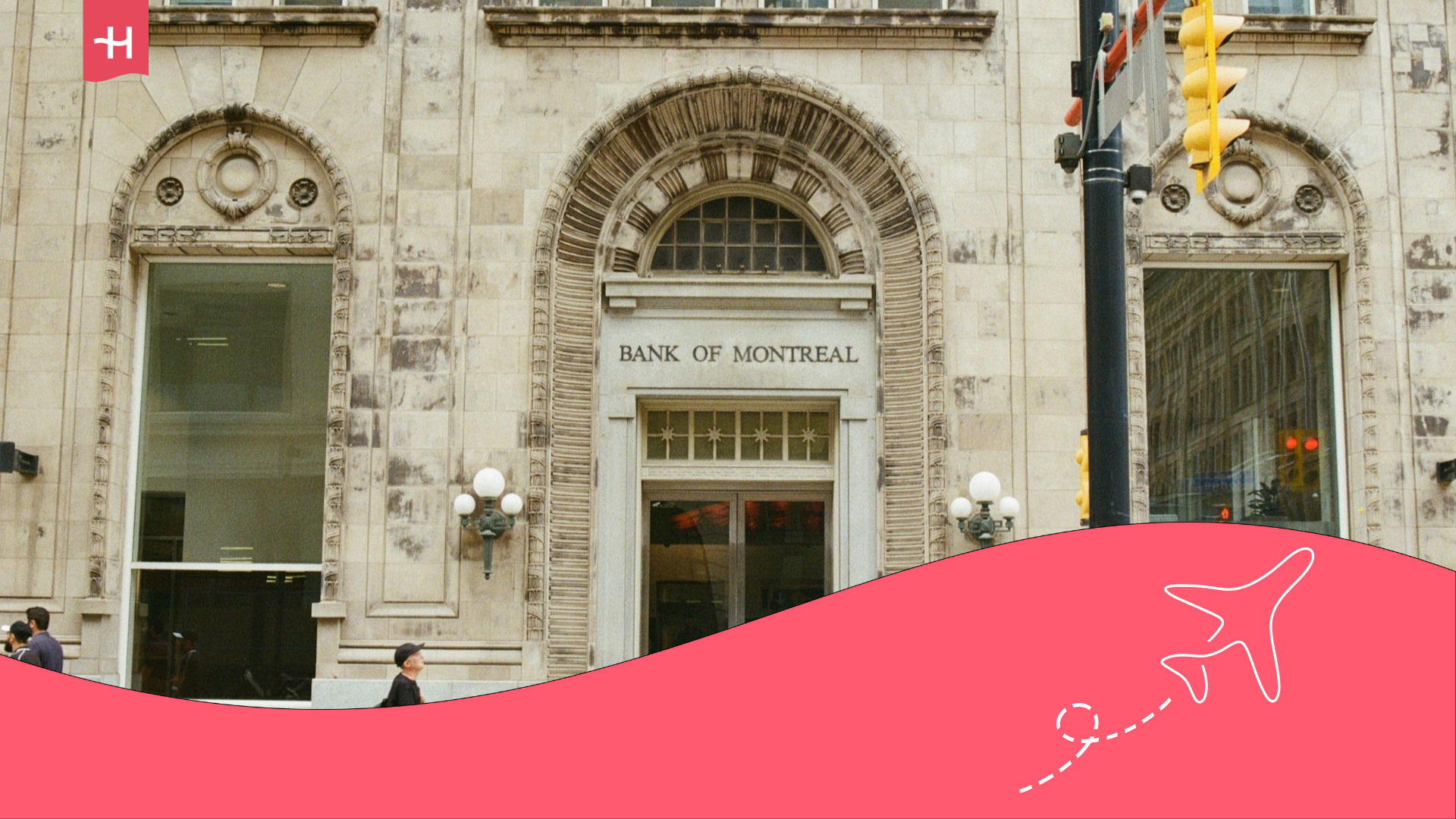Cost of living in California: Food, transport, and more
Cost of living in California: find out expenses, lifestyle and why living in this US state can be worth it despite its high prices.
California is that state everyone hears about at some point. Whether for its golden beaches, mild weather, Hollywood film studios, or famous Silicon Valley. Yet beyond the postcard image, you must know that the cost of living in California isn’t low at all.
In this article, we’ll show you how much it costs to live in California in 2025, so you can plan if considering moving. You’ll find figures on rent, transport, food, education, healthcare, and even how much you need for occasional treats.
It’s not the same living in Los Angeles as in Sacramento, or moving with a secured job compared to arriving as a student. Not every expense is visible, but many make a real difference at the end of the month.
Keep reading and find out if California is really a viable destination for your budget.
Accommodation in California: Prices for furnished flats, coliving, Airbnb, and student residences
Discussing the cost of living in California means looking closely at accommodation, since it’s one of the biggest monthly expenses. And indeed, differences between cities can be massive.
- San Francisco, Los Angeles, and San Jose rank among the most expensive places not only in California, but across the United States, with rents easily above $2,500 (€2,350) per month for a one-bedroom flat in central areas.
- Meanwhile, cities like Sacramento, Fresno, or Bakersfield are far more affordable, with prices up to 40% lower than the coast. These areas attract students and families seeking balance between quality of life and reasonable costs.
- There are also smaller towns increasingly appealing for digital nomads, such as Santa Cruz or Palm Springs, where life is calmer, nature is closer, and although rents aren’t cheap, they can still be more competitive than in large urban centres.
In summary, your California experience changes drastically depending on the city you choose: from San Francisco’s luxury and energy to the relaxed air of lesser-known coastal communities.
1- Furnished flats in California
Furnished flats are the most popular choice for those arriving in California for a season, since they allow settling without worrying about buying furniture or appliances. However, location makes a huge difference in prices.
- In San Francisco or Los Angeles, a one-bedroom furnished flat in the city centre costs between $2,800 (€2,630) and $3,500 (€3,285) per month, while in outer neighbourhoods the figure drops to around $2,000 (€1,880) monthly.
- If we look at more affordable cities like Sacramento, Fresno, or Bakersfield, prices fall significantly: a similar flat starts from $1,200 (€1,130) to $1,600 (€1,505), making these cities a viable alternative for students, remote workers, and young families.
- In destinations popular with digital nomads, such as Santa Cruz or Palm Springs, rents usually range between $1,800 (€1,690) and $2,200 (€2,065), with the advantage that many buildings include coworking spaces, gyms, or communal areas for easier socialising.
In conclusion, furnished flats in California provide comfort and practicality, but it’s essential to carefully assess the city you choose, since costs can double or triple depending on the area.
2- Airbnb stays in California
Renting via Airbnb has become a very popular option for those planning to stay in California for weeks or even months. Flexibility, the chance to choose between full houses or studios, and managing everything from an app are strong advantages over traditional flats.
- In expensive cities such as San Francisco or Los Angeles, a small studio or flat on Airbnb costs between $3,000 (€2,820) and $4,200 (€3,950) monthly, usually including furniture, internet, and utilities. Though pricey, it’s often more practical than signing a long-term rental for short stays.
- In mid-range cities like San Diego or San Jose, monthly prices usually range from $2,000 (€1,880) to $2,800 (€2,635), while in more affordable places like Sacramento or Fresno, options start from $1,200 (€1,130) to $1,800 (€1,695), with many hosts offering generous discounts for long bookings.
- A strong plus is that in tourist spots like Santa Barbara, Santa Cruz, or Palm Springs, many Airbnb properties also include extras like bike rentals, access to shared pools, or personalised local recommendations.
In short, Airbnb is more expensive than monthly rent in less popular areas, but it delivers greater flexibility and convenience, especially if your plan is moving between several Californian cities without committing to a fixed contract.

3- Coliving: An alternative for digital nomads in California
If you travel as a digital nomad or international student, living in a coliving space can be an excellent option. This type of housing combines private or shared rooms with common spaces, creating the perfect environment to network and socialise with people worldwide.
In cities like San Francisco and Los Angeles, coliving spaces are increasingly popular. For example, Outsite San Francisco – Pacific Heights offers private rooms from $1,800 (€1,695) to $2,500 (€2,355) monthly, with access to coworking and community activities. In Los Angeles, Common Melrose offers rooms from $1,600 (€1,505) per month, in the cultural district, including high-speed internet, weekly cleaning, and lounge areas.
If you’re seeking more affordable options, San Diego hosts spaces such as International Travelers House Coliving, where monthly prices range from $1,200 (€1,130) to $1,800 (€1,695). The vibe is much more relaxed, perfect for combining beach and remote work.
Furthermore, in university towns such as Berkeley or Davis, certain coliving spaces are designed for international students staying for full semesters. These settings ease integration and are often cheaper than renting an individual flat.
Coliving in California offers flexible contracts, included services, and a socially enriching environment, making it an ideal choice compared to traditional rentals or Airbnb, especially if you plan to stay several weeks or months.

4- Cost of living in California: Student residences as housing alternatives
University residences in California are one of the most practical choices for those arriving to study, since they provide housing within or near campus with all basic services included. They also foster a multicultural environment, making it easier to make friends and adapt faster to academic life.
At prestigious universities like UCLA (Los Angeles) or Stanford (Palo Alto), shared rooms cost between $1,200 (€1,130) and $1,800 (€1,695) monthly, while single rooms can exceed $2,000 (€1,880) per month. These costs cover electricity, internet, university dining, and sometimes gyms or cultural activities.
In smaller university towns such as Santa Cruz, Davis, or Irvine, prices are more affordable. There, student residences usually range from $900 (€845) to $1,300 (€1,220) monthly and often include double or triple rooms, plus access to libraries, coworking, and recreational spaces.
One clear advantage of residences is safety and time-saving, since living on campus avoids long commutes. They’re also an excellent choice for semester or full academic year stays, as universities usually prioritise international students for housing.
In summary, student residences in California may cost more than in other US states, but they provide comfort, convenience, and a social environment that supports both study and daily life. Eating in California:
Prices in supermarkets and restaurants
Eating in California varies a lot depending on where you live and your habits. While supermarkets offer affordable products if you choose wisely, dining out in cities like San Francisco or Los Angeles can blow up your monthly budget.
Here’s a comparative table with average prices of basic foods in three popular Californian supermarket chains: Trader Joe’s, Safeway, and Walmart.
| Product (unit or kg) | Trader Joe’s | Safeway | Walmart |
|---|---|---|---|
| Milk (1L) | $1.50 | $1.70 | $1.30 |
| Bread (500 g) | $3.00 | $3.50 | $2.50 |
| Eggs (12 units) | $4.00 | $4.50 | $3.80 |
| Chicken (1 kg) | $10.00 | $11.50 | $9.50 |
| Apples (1 kg) | $4.00 | $4.50 | $3.50 |
| Rice (1 kg) | $3.50 | $4.00 | $3.00 |
| Cheese (500 g) | $7.00 | $8.00 | $6.50 |
Food prices at major supermarket chains in California
If you cook at home, you’ll save quite a lot: average monthly supermarket spending ranges between $300 (€280) and $450 (€420) per person, depending on the city and chosen products.
However, when dining out, city differences become clear:
- In Los Angeles, a simple lunch at a budget restaurant costs $18 (€17)–22 (€21), while dinner for two at a mid-range restaurant can exceed $80 (€75).
- In San Francisco, prices rise higher: a budget meal costs around $20 (€19)–25 (€24), and a full dinner can reach $100 (€94) for two.
- In contrast, San Diego or Sacramento are slightly more affordable: lunch at a cheap spot costs $15 (€14)–18 (€17), and dinner for two ranges $65 (€61)–75 (€71).
In summary, cooking at home is the best strategy to save in California, especially in large cities. Dining out often becomes an occasional luxury in Los Angeles and San Francisco, while smaller towns keep prices a little more manageable.

Cost of living in California: Transport and mobility
Getting around California means adapting to each city. San Francisco stands out with varied and relatively efficient public transport, while in Los Angeles using a car is almost essential. San Diego combines both, and in smaller cities like Sacramento, mobility is a bit more affordable.
Here’s a table with average transport costs in California’s main cities:
| Category | San Francisco | Los Angeles | San Diego | Sacramento |
|---|---|---|---|---|
| Single ticket (bus/metro) | $3.00 | $1.75 | $2.50 | $2.00 |
| Monthly transport pass | $90.00 | $50.00 | $72.00 | $60.00 |
| Taxi (initial fare) | $4.50 | $3.00 | $3.50 | $3.00 |
| Taxi (1 km) | $2.00 | $1.75 | $1.80 | $1.60 |
| Petrol (1 litre): | $1.35 | $1.30 | $1.32 | $1.28 |
Cost of living in California: Transport and mobility
- San Francisco has metro (BART), buses, and electric trams, making it easy to move without a car, though passes are among the state’s most expensive.
- Los Angeles is so spread out that cars are nearly essential. There’s a metro and bus network, but it doesn’t cover the county fully and journeys often take long.
- San Diego has the Trolley and buses connecting downtown and nearby districts, which allows some people to live without a car.
- Sacramento has cheaper costs and basic city coverage, although it’s less efficient compared to San Francisco.
On the other hand, private transport apps play a key role in Californian cities, especially where public transport isn’t enough. Uber is the most popular, operating across the state, from large cities to suburbs. Lyft is also widely used. Many users compare both apps before booking since prices often vary. You should do the same.
On average, a short Uber or Lyft ride within San Francisco costs $10 (€9)–15 (€14), while in Los Angeles (where distances are longer) you usually pay $18 (€17)–25 (€24) per trip.
In conclusion, those seeking savings prioritise cities with solid public transport. Yet in much of California, the car still dominates, and maintaining one means high monthly expenses for fuel, insurance, and parking. For more details, read our guide on driving in the United States.

Healthcare in California
One of the most important factors when calculating the cost of living in California is healthcare, since the United States doesn’t have a universal public system. In this state, medical consultations and hospital stays are particularly expensive if you don’t have health insurance, so getting one should be your first step.
A basic private health plan costs between $300 (€280) and $500 (€470) per person each month, although prices vary by age, medical history, and coverage. Family insurance usually exceeds $1,200 (€1,130) monthly, and in many cases employers offer group policies that ease the burden.
Without insurance, a simple doctor’s visit costs around $150 (€140)–250 (€235), while an emergency room visit can easily exceed $1,000 (€940). Hospitalisation, instead, runs into thousands of dollars per day, making insurance almost indispensable.
For medication, California prices are higher than in many other states. A common prescription ranges from $20 (€19) to $100 (€94), depending on the drug and whether a generic exists.
A positive note is that in cities like San Francisco, Los Angeles, or San Diego, there are community clinics and low-cost programmes for students, immigrants, and digital nomads who meet certain criteria, which can make care more affordable.
In short, for anyone moving to or staying long term in California, including health insurance in the monthly budget isn’t optional but a necessity.
Cost of living in California: Mobile, home internet, and data plans
Connectivity is a key expense within the cost of living in California, for digital nomads, students, and long-term travellers alike. The good news is that the state has one of the best technological infrastructures in the United States, guaranteeing high-speed internet access in almost every city.
- For home broadband, providers like AT&T, Spectrum, or Xfinity offer plans ranging between $50 (€47) and $90 (€85) monthly, depending on the speed and city. Fibre optic packages are pricier but ensure better stability for remote workers.
- For mobile internet, major carriers (T-Mobile, Verizon, and AT&T) sell unlimited plans costing $60 (€56) to $90 (€85) per month. These prices can drop with family bundles or long-term contracts.
However, for those avoiding contracts, the most practical option is the Holafly eSIM, which lets you arrive in California with active internet from the first moment. Holafly offers unlimited data plans from five to ninety days, ideal for both short and long stays. Yet, if you plan to remain longer in California, Holafly Plans may be the best option.
Important: If you are a frequent traveler and want to stay connected without worrying about expensive roaming or looking for a new SIM at every destination, Holafly’s subscription plans are for you. With a single eSIM, enjoy internet in more than 160 countries for a fixed price and no surprises on your bill. Travel without limits and connect easily and securely! 🚀🌍

In public spaces like cafés, libraries, universities, or tourist areas, free WiFi is very common, especially in San Francisco, Los Angeles, and San Diego. Still, for constant and secure use, relying on an eSIM or a personal plan is recommended.
In conclusion, staying connected in California isn’t a problem, but it’s an expense ranging between $50 (€47) and $100 (€94) monthly, depending on the chosen option.
Leisure and entertainment in California
Talking about the cost of living in California also means considering how much someone spends on free time. And here, options are vast: from free outdoor activities to exclusive experiences that only this state offers.
Among free choices, California is a natural paradise. In Los Angeles, you can stroll through Griffith Park and enjoy views of the famous Hollywood sign without spending a cent. Beaches like Santa Monica, Venice Beach, or La Jolla in San Diego are perfect for sand and sea without charge. Meanwhile, San Francisco offers unforgettable walks through Golden Gate Park, with gardens and lakes open to everyone.
When it comes to paid activities, prices vary greatly:
- Entrance to theme parks such as Disneyland in Anaheim or Universal Studios Hollywood costs $110 (€103)–150 (€141) per day.
- Film fans can join a Warner Bros. Studio tour for about $70 (€66).
- Museums are also part of the cultural plan: Los Angeles’ LACMA charges around $25 (€24), while the Exploratorium in San Francisco costs $30 (€28).
Nature lovers can explore California’s great national parks.
- Entry to Yosemite National Park costs $35 (€33) per vehicle.
- Sequoia National Park charges similar fees.
- These passes usually remain valid for seven days, making them excellent for planning full excursions.
On average, a person spends between $100 (€94) and $300 (€282) monthly on leisure, depending on city and lifestyle. While in small towns entertainment centres on outdoor and low-cost activities, in cities like Los Angeles or San Francisco paid options are much more tempting.
In short, leisure in California is as varied as its geography. You can spend little and enjoy a lot, or invest in unique experiences that define your trip.

Conclusion: How high is the cost of living in California?
The cost of living in California is undoubtedly among the highest in the United States. Differences between cities are striking: while San Francisco and Los Angeles lead the list of expensive places, smaller and more affordable towns attract those seeking balance between lifestyle quality and budget.
Housing, transport, and healthcare usually impact the budget the most, but they vary greatly by city and personal lifestyle. Food and leisure, on the other hand, offer both budget-friendly and premium options, allowing adaptation to different financial situations.
Although moving or staying long term in California requires serious financial planning, the cultural richness, job dynamism, diverse landscapes, and unique experiences compensate for the investment. Ultimately, living in California means being at the heart of innovation and surrounded by places rarely found elsewhere in the world.





 Language
Language 


















 No results found
No results found








